There comes a time in every sleeper’s life when they have to learn how to clean a mattress. And if you’re reading this, that time is now. So grab your gloves, folks, because I’m about to show a full-proof method for zapping stubborn stains, eliminating icky odors, and getting your mattress looking (and feeling!) fresh again.
To show you how to use the method, the below video shows a mattress that one of our testers has dirtied up with coffee, red wine, food stains, a urine duplicate, and a blood duplicate that have set for days. Throughout this article, I’ll also be answering questions about mold and more stains!
So, without further ado, let’s get into it!
Why Is It Important To Clean My Mattress?
Even if your mattress doesn’t look dirty, it’s important to note that dust mites, bacteria, and musty odors are bound to build up over time. And beyond that, snoozing on a clean, fresh-smelling mattress can actually help you get better Zzz’s, too.
To get more specific, cleaning your mattress can help with:
- Dust Mites – Dust mites are tiny insect-like pests that feed from the skin cells you shed each night. And because you shed millions of skin cells per week, the average mattress contains tens of thousands of dust mites eagerly awaiting their next meal. (1)

- Allergens – Tossing and turning in bed can stir up dust particles that live in your mattress, and release them into your bedroom. Even if you’re not allergic to dust, breathing it in all night can lead to nasal congestion, itchy/watery eyes, and throat irritation. (2)
- Night Sweats – Regardless of whether you run hot or cold, you’re likely to sweat while you sleep. The sweat from your body goes right into the surface of your mattress, making it a moist breeding ground for bacteria. (3)
- Sleep Quality – And finally, you’ll probably sleep more peacefully if you know your mattress isn’t crawling with dust mites. In fact, making your bed in the morning, keeping your sheets clean, and resting on a clean mattress can help you fall asleep faster and sleep soundly through the night.
With all that said, deep cleaning your mattress at least twice a year will cut down on bacterial buildup and help keep those allergens at bay. Of course, accidents happen, and sometimes your bed gets so messy that an immediate clean is necessary. So before I tell you how to get your sleep space glowing again, let’s talk supplies.
More: Check out our guide on how often you should replace your mattress!
DIY Mattress Cleaning Supplies
There are a variety of ways to clean your mattress, many of which include popular name-brand cleaning solutions that you can find online or in stores. But here’s a DIY method that’s effective, non-toxic, and involves basic household items you probably already have.
So let’s first take a look at everything you’ll need to start cleaning the stains:
- Hydrogen Peroxide
- Several boxes of baking soda (it depends on the size of your bed, but we suggest having at least three boxes to be on the safe side)
- Clear dish soap (nothing green or blue as it could stain your mattress)
- A spray bottle
- A toothbrush
- A few white rags
- A vacuum cleaner
- Sifter (optional)
- Essential oil (optional)
You can use the above supplies to clean blood and urine stains, but to double down on them, you’ll also need:
- White distilled vinegar
- Another spray bottle
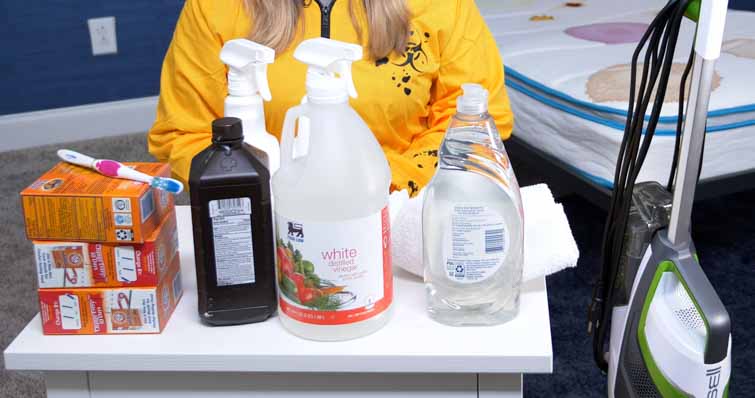
Once you’ve assembled your supplies, it’s time to head to the bedroom and strip your mattress of all bedding. As you gather all your sheets and pillows, let’s discuss expectations.
Setting Expectations
Let me start by saying that cleaning your mattress is not going to make it look brand new again, and it’s important to set reasonable expectations before you begin. Afterall, every stain and mattress is different, and there are a few key factors to keep in mind as you clean.
- Old & New – It’s important to remember that the stain you just made on your mattress is probably going to disappear quicker and more completely than the stain that’s been there for years.
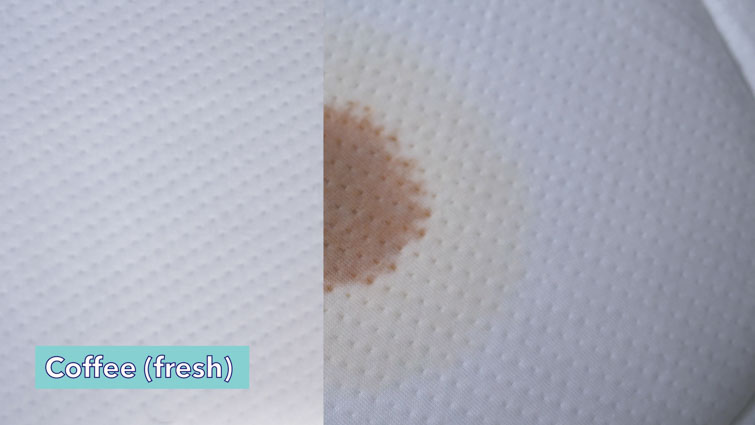
- Light & Dark – Similarly, really dark stains made by things like coffee or chocolate might still be slightly visible by the time you’re done cleaning. Don’t worry, this doesn’t mean your mattress isn’t clean; it just means that the stain was too dark to erase entirely (especially if your mattress is white).
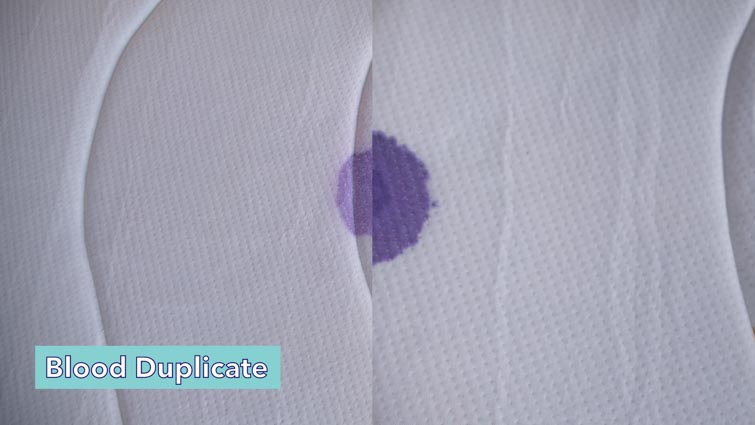
- Time & Patience – Before you pick up your spray bottle, it’s very important to note that deep cleaning your mattress takes time and patience. Between all the vacuuming and spraying and drying, this is not a task to take on when you’ve got a spare 15 minutes. Instead, you should set aside a full day, and plan to sleep on the couch while your mattress dries overnight.
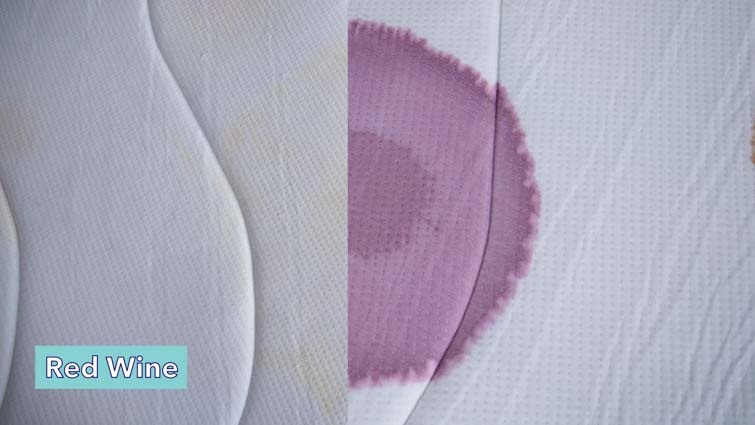
That said, the method we’re showing you can treat everything from grass stains and wine spills to blood and bed-wetting accidents. And just in case your mattress doesn’t sparkle after the first treatment, we’ll show you how to double down on stain and odor removal too.
With these things in mind, let’s get down to business.
How Do I Clean My Mattress?
Pictured below is our step-by-step guide to deep cleaning your mattress. Keep all your supplies nearby before you begin, and change into some clothes you don’t mind dirtying (you will get baking soda on yourself).

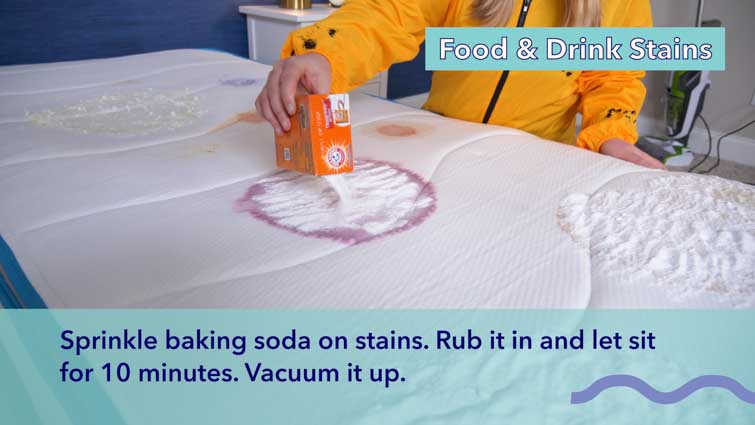
Set a timer for 10 minutes, and let the baking soda do its thing. Keep in mind that baking soda lifts bad odors and moisture away from your mattress, so it’s important to let it sit for at least 10 minutes.
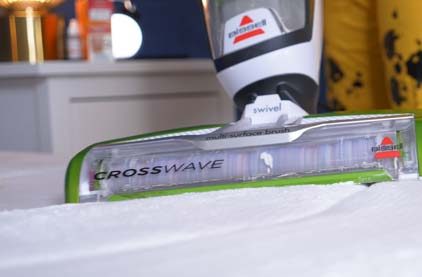
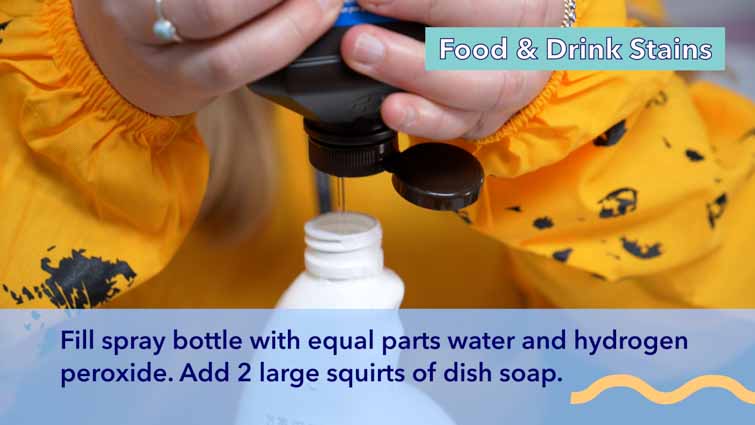
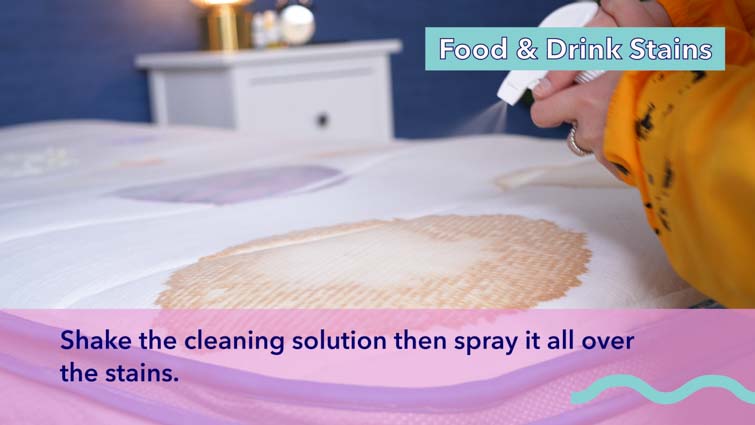
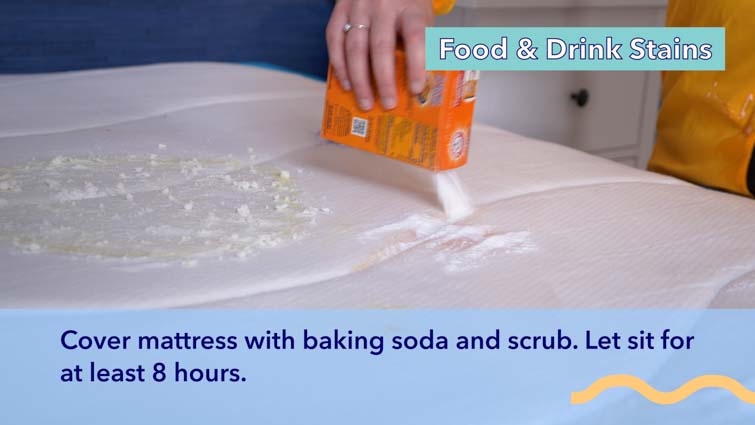
Now, we wait. It’s best to let your mattress sit overnight in order for the cleaning solution to take full effect, so plan to spend the night on the couch or an air mattress.
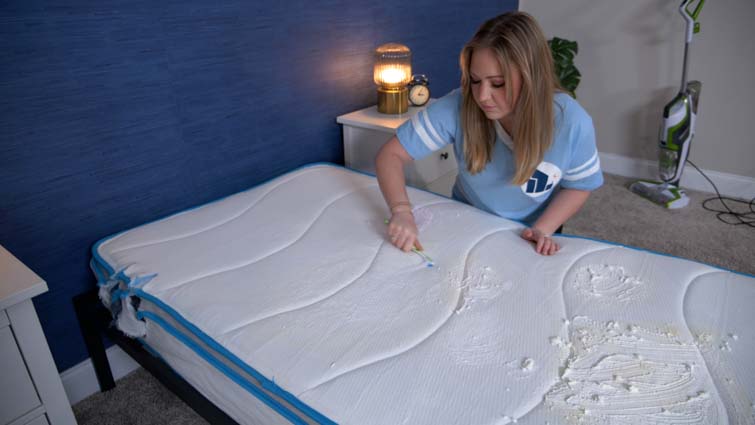
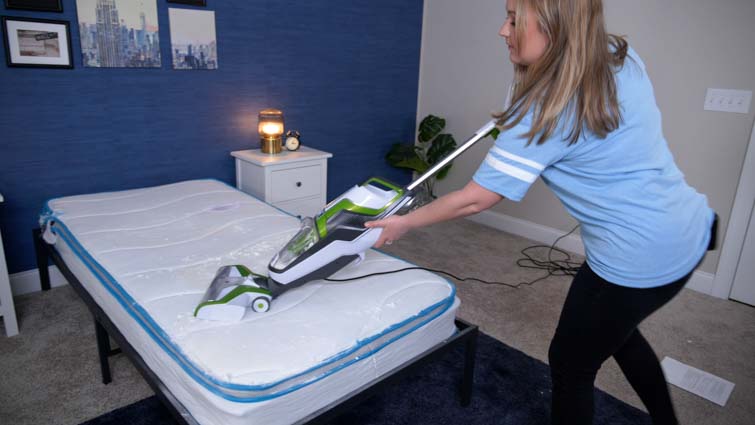
Now, check out your results!

Blood, Urine, and Mold
By now you might be thinking, “Why did you tell me to get distilled white vinegar if I didn’t need it?” Well, the method we just showed you can treat stains made from blood or urine, but if the blood is still slightly visible, or the urine still smells a little funky, it’s time to break out the vinegar.
Combine a few capfuls of distilled white vinegar with a few tablespoons of baking soda, and mix it up until it forms a paste. Then, spread the paste over the stains and let it sit for at least an hour. After that, the paste will be hard enough to break and peel off the mattress, taking the stinky stain with it. Be sure to vacuum your mattress again to get rid of any baking soda debris, and you should be good to go!


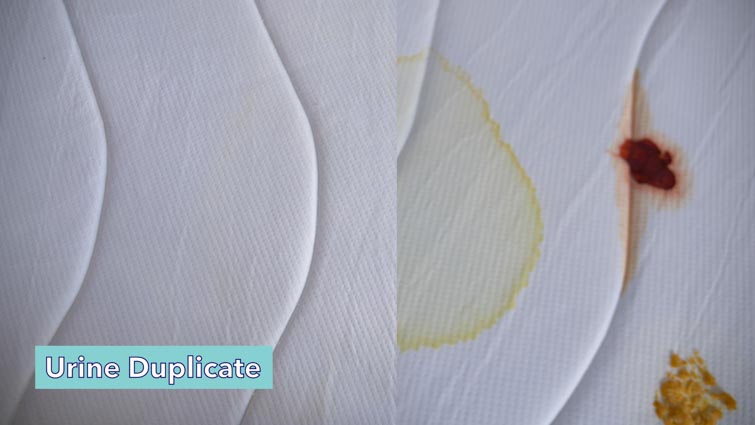
Mold, on the other hand, is a trickier issue because it can be detrimental to your health. If you notice that your mattress has become moldy, we strongly suggest that you replace it. Even if it means sleeping on the couch for a new nights, I don’t recommend taking any risks when it comes to mold.
If you’re not sure whether or not you’re dealing with a moldy mattress, check for green, grey, or black spots forming on the fabric. Oftentimes, mold accumulates in little dots rather than one large stain, and usually looks fuzzy in texture.
Read More: How to Get Blood Out of a Mattress
Protecting Your Mattress
Once you’ve given your mattress a nice deep clean, keep it pristine by following the guidelines I’ve listed below. These suggestions aren’t necessarily mandatory, but they can really help keep your sleep space clean.
- Get a Mattress Protector – You can’t over-stress the importance of a mattress protector. They are relatively inexpensive (usually ranging from $25–$200), can be found online or in stores, and go a long way in keeping your mattress clean. Additionally, most protectors are waterproof which means if you spill something, your protector has you covered.
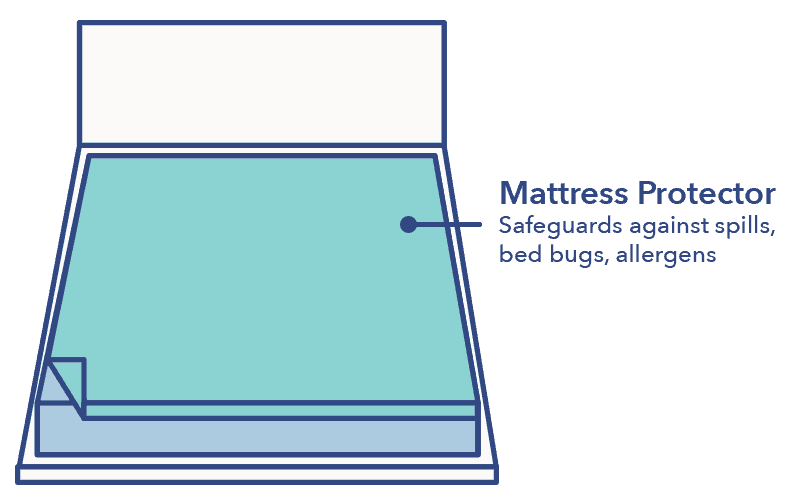
Beyond stains, mattress protectors can keep dust mites and other allergens at bay as well. Think of it as an antimicrobial barrier between your mattress and the outside world. And if you’re not sure where to start shopping, check out our review of the Malouf Mattress Protector and the Bedical Care Mattress Encasement.
- Wash Your Bedding Once A Week – Your bedsheets can harbor a lot of bacteria, and should be cleaned once a week. By keeping your sheets and pillows cleaned, all the icky dust mites and germs that might live in your bedding are much less likely to spread to your mattress. For more info on this, be sure to check out our guide to cleaning your sheets!
- Bedtime Habits – It may be tempting, but eating food in bed and/or allowing your pets to sleep with you can increase the amount of dust mites and bacterial buildup in your mattress. Not to mention, you’re more likely to spill something if you’re dining in your bedroom!
Now that you’re equipped with all the info needed to clean and protect your mattress, we’re almost at the end of this review. But before you go, let me tell you a bit more about our own experience using this method so that yours will be as efficient as possible.
Is This The Right Cleaning Method For Me?
As you can see, this cleaning method worked wonders on the various stains that once covered the mattress. However, there are a few things to keep in mind about this particular process in order to make your experience as quick and effective as possible.
- Brushing – Using a toothbrush to scrub the baking soda into your mattress does work, but if you can, we recommend using a vacuum brush. In our experience, the toothbrush was ideal for breaking up baking soda residue in small, concentrated areas. But we found it to be a bit too small to use on the entire surface of the mattress. Additionally, vacuum brush bristles are stiffer, stronger, and less likely to fall off as you scrub.
- Baking Soda – We can’t lie — by the time we were done cleaning, we were covered in baking soda. It’s a small price to pay for great results, but I’m going to prepare a little differently next time. For example, wearing black was a bad move.
Also, we think emptying the baking soda from your vacuum after each use might make the mess a bit more manageable. And lastly, don’t underestimate the amount of baking soda you’ll need, as it’s a hassle to have to go out and buy more mid-clean (again, we suggest having at least three boxes).
- Ventilation – Yes, while this is a non-toxic cleaning solution, there’s still a baking soda aroma that, frankly, we found rather unpleasant. So we suggest (weather permitting) that you keep your bedroom windows cracked while you clean for a little ventilation.
That said, we were very impressed by how well this method worked (honestly didn’t think that oil & vinegar stain was going to come out) and we fully intend to use it again. But if you’re still not sure that this is the right technique for you, let’s recap some highlights:
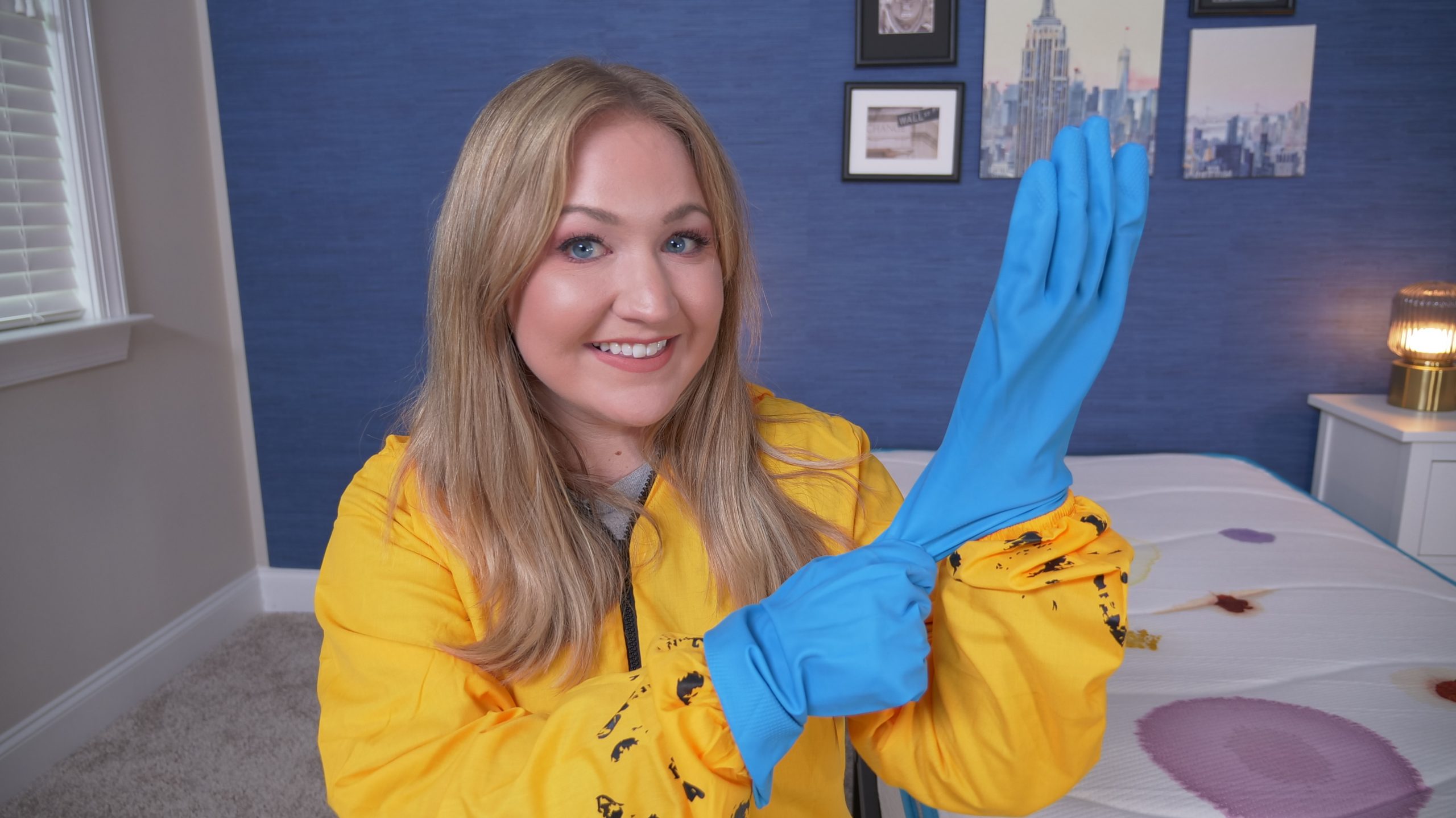
- Budget-Friendly – Many of you may already have several (if not all) of the supplies you need to start cleaning. But we bought every single item brand new, and it all cost me less than $50. If you want to avoid paying top dollar for a professional cleaning service and/or name-brand products, this method is effective and easy on the wallet.
- Non-Toxic – For me, using a non-toxic cleaning solution is top priority. Products that contain bleach and ammonia may effectively remove stains but, personally, we don’t want to sleep on a mattress that’s been treated with those chemicals. If you feel the same way, take comfort in the fact that this method is totally non-toxic.
- Deep Cleaning – This mattress-cleaning method doesn’t just remove surface stains! By the time we were done cleaning, we could see that the deep, dark stains that had been there for days had all but disappeared. Additionally, the mattress was left with a freshly cleaned smell (once the baking soda aroma wore off) that we quite enjoyed.
Final Thoughts
Okay sleepers, now that you know how to clean your mattress (and keep it clean with a protector!), I’m going to leave you with a few final words of wisdom.
- Calming Aromas – Baking soda draws the bad odors out of your mattress, but adding a couple droplets of an essential oil to your cleaning solution takes odor elimination to the next level. Personally, we like to use either lavender or eucalyptus, but feel free to experiment with the scents that make you feel most at home. Remember: you’ll do this when you mix your cleaning solution, before you start to spray the mattress.
- Check with the Company – Keep in mind that all stains are different, and the method we just showed you might not be equally effective across all mattresses and materials. This is why it’s always best to consult the mattress company itself for specific wash care instructions. After all, no one knows how to clean your bed better than the folks who made it.
- Singular Spills – If you’re trying to tackle one isolated spill that you just made (and your mattress is otherwise clean), cover it with baking soda immediately. This will pull most of the moisture out, and then you can spot clean with mild detergent as needed.
- Twice a Year – While using a mattress protector is a great way to guard against spills and stains, we still spend a third of our lives in bed and it’s best to give your mattress a deep clean twice a year. Remember, Taking good care of your mattress is an investment in your sleep health.
Well that’s all she wrote! Now you know how to clean your mattress using a handful of trusty household items. Just be sure to wash your bedding regularly, keep your mattress protected, and give it a deep clean twice a year. Do these things, and you and your mattress should enjoy a long and dreamy relationship for years to come.
If these tactics don’t work and it’s time to get a new mattress you can take our mattress quiz to start your search with a few recommendations on great options for your specific sleep preferences.
In the meantime, don’t forget to subscribe to our YouTube channel and follow us on Facebook, Twitter, and Instagram for the answers to all your sleep needs!
***Sarah Riccio and Bridget Chapman contributed additional research and reporting to this piece***
FAQs
How do you deep clean a mattress?
There are several ways to deep clean a mattress, but I suggest using baking soda and a cleaning solution made from dish soap, water, and hydrogen peroxide. You will coat your entire mattress in both baking soda and the cleaning solution, and then let it sit for at least 8 hours!
Can you shampoo a mattress?
You can use an upholstery shampoo on the surface of your mattress in order to eliminate tough stains, but I suggest carefully checking its ingredients to make sure its non-toxic and body-safe.
How often should you clean your mattress?
In general, it’s best to clean your mattress twice a year, or once every season. Of course, if you soil your mattress, clean it immediately to keep the stain from setting in.
Is it good to vacuum your mattress?
Absolutely! In fact, going over the surface of your mattress with a vacuum cleaner once a month is a great way to cut down on dust mites, pet dander, and bacterial buildup.
References
- Portnoy, Jay, et al. “Environmental Assessment and Exposure Control of Dust Mites: a Practice Parameter.” Annals of Allergy, Asthma & Immunology : Official Publication of the American College of Allergy, Asthma, & Immunology, U.S. National Library of Medicine, Dec. 2013, www.ncbi.nlm.nih.gov/pmc/articles/PMC5156485/.
- Calderón, Moisés A., et al. “Respiratory Allergy Caused by House Dust Mites: What Do We Really Know?” Journal of Allergy and Clinical Immunology, Mosby, 22 Nov. 2014, www.sciencedirect.com/science/article/pii/S0091674914014821.
- Boor, B. E., et al. “Characterizing Particle Resuspension from Mattresses: Chamber Study.” Wiley Online Library, John Wiley & Sons, Ltd (10.1111), 12 Sept. 2014, onlinelibrary.wiley.com/doi/abs/10.1111/ina.12148.

Livvi DiCicco
Staff Writer
About Author
Livvi DiCicco is a Staff Writer and Certified Sleep Science Coach. She has been writing, editing, and researching sleep-based content for over a year. After graduating from the University of Iowa with a degree in English & Creative Writing, she decided to work in the digital marketing field, continuing her creative works on the side. Her other interests (besides napping and writing) include digital art, history, and boba tea.
Combination Sleeper





























